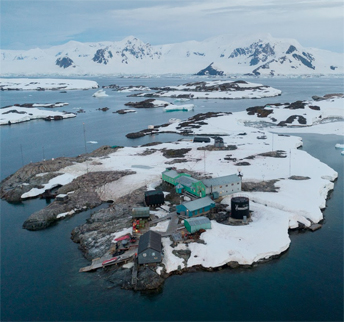What happens if there is a fire in Antarctica? A serious question regardless of all the snow and ice; for Antarctica is the windiest place on earth, where hurricane-force winds can blow. Even a tiny flame can quickly turn into a large blaze.
Most of the buildings at Antarctic research stations were built decades ago. These are often small wooden houses with metal panels insulated with foam. When the foam burns, it releases deadly phosgene gas. In 2020, there was a short circuit at the Russian “Mirny” station. The fire burned down laboratories, the radio room, and other buildings.
In the spring of 2021, the Vernadsky Research Base, a Ukrainian Antarctic Station, pictured, was equipped with an Ajax security system featuring FireProtect and FireProtect Plus fire detectors. The Ajax equipment was delivered at a distance of 16 thousand kilometers and now protects the scientific base in Antarctica.
At any time, some ten to 14 members of the Ukrainian expedition are living at Vernadsky. They are scientists and the people who run the station. Every year, one team of polar explorers replaces the other.
They study the Southern Ocean, the Earth’s magnetic field, and the frozen continent’s climate, flora, and fauna. For example, they record the “languages” and “dialects” of whales, monitor the hole in the ozone layer, and make daily meteorological measurements to predict the weather worldwide and global climate change.
Vernadsky had a fire alarm, but no one upgraded it for 36 years (since 1985). For the first ten years, the base was used by British polar explorers. At the time, the base was called “Faraday” and belonged to the UK. Since then, it changed name, flag, and country, but not its fire detection equipment. The old system malfunctioned and caused false alarms. Some detectors were inoperable. But finding spare parts for them (let alone bringing them to Antarctica) was becoming more difficult.
As a polar station is a complex of buildings, it is important to cover them with one system. For this, the most reliable radio communication with a long range is required. As for maintenance, you cannot very well invite an installer to Antarctica; the station engineers maintain the system themselves. It mustn’t require a lot of attention. Devices must operate from batteries for years, and alert if something goes wrong. For example, if a detector loses connection or if batteries need to be replaced in a couple of months.
A person at Vernadsky station monitors the system. A system with a handy alarm-monitoring app for PCs as well as loud sirens to alert people to danger is required. During the cold season, the temperature outside drops to minus 27 degrees C. In residential premises , it is kept at plus 16 to 18 degrees C, and in non-residential ones, it is kept with a slight “plus”. The specifications of the detectors must correspond to these conditions.
The policy at Vernadsky is to buy Ukrainian. And not to economise – in Antarctica, the price of failure can be high, and shipping costs a lot of money, points out Viacheslav Marchenko, Deputy Director of the National Antarctic Scientific Center (NASC). He says: “A marker was triggered: if a security system — then Ajax. And we were not mistaken with the choice.”
In addition to the hub (the security system control panel) and two sirens, ten Ajax fire detectors were delivered to Galindez Island in West Antarctica. They protect against fire, detect smoke and rapid temperature swings, and against carbon monoxide poisoning.
Photo courtesy of Yevhen Prokopchuk.










